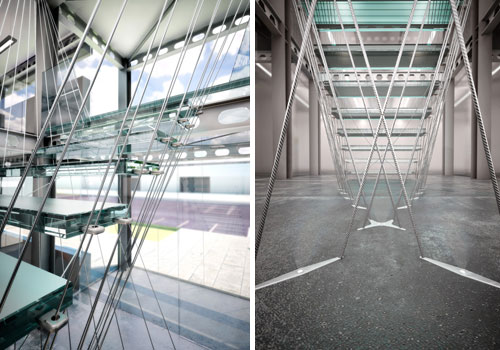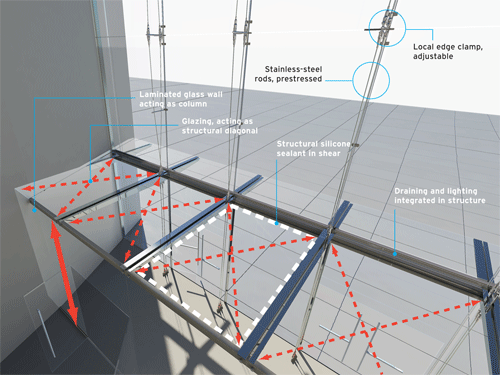Shattering Myths About Glass
The 4-foot-wide staircase is centered in the foyer of a newly built, all-glass box within an existing traditional industrial building. It may be the first staircase to form a true tensegrity structure (Buckminster Fuller - who coined the term - created what is probably the most famous type of tensegrity structure, the geodesic dome). As such, the solid members, or glass, are loaded under pure compression, with the cables providing all the tension.
 "What's unique about the staircase is that we don't have any stringers in the conventional sense of two bending beams," says Thornton Tomasetti's Wilfried Laufs. "We prestressed thin cables like a harp from the floor to the ceiling and clipped the glass treads in between. There are no beams or slabs or walls in this system at all." Instead, the inclined cables are tensioned against the floor and ceiling, where castellated steel beams receive the cable ends and transfer the loading over to the main building-structure columns.
 |
Left: Prestressed cables running from the floor to the castellated steel beams overhead carry the glass treads. Right: A fish-bow truss beneath the treads provides lateral stability. Images: Grimshaw Architects |
Â
Underneath the treads, the 1â„4-inch-diameter cables form a fish-bow truss in order to avoid staircase vibrations and stabilize the treads laterally. Vibration control is most critical compared with static deflection and stress limitation for this type of staircase. EASY Technet, a specialty German software for lightweight surface structures, was used to determine the critical lowest vibration modes both unloaded and loaded with people at different locations.
The treads are made up of laminated safety glass. Ionoplast is used to bond the four glass layers to each other, and the stainless-steel connectors to the glazing. As standard practice, the top layer, referred to as the "sacrificial layer," is assumed to be broken for calculations. "Imagine you would drop a sharp metal suitcase and that top layer would break while you're standing on it," Laufs explains. "We already don't take that into account."
The designers will use annealed glass, or basic float glass, so that the edges can be polished. (The same polish is not possible with heat-strengthened, or tempered, glass.) A continuous weaving handrail will be assembled along the cables, which will be lit from the floor.
Another project by Thornton Tomasetti, this time in collaboration with Pelli Clarke Pelli Architects, also aims to maximize transparency while minimizing structure. A mixed-use development currently under construction in Washington, D.C., features two structural-glass entry walls that enclose an atrium and provide a daylight-filled walkway through the complex.
 |
For a mixed-use development under construction in Washington, D.C., designed by Pelli Clarke Pelli, two structural-glass entry walls enclose an atrium that links two commercial buildings and leads from the street to the courtyard. Image: Thornton Tomasetti |









